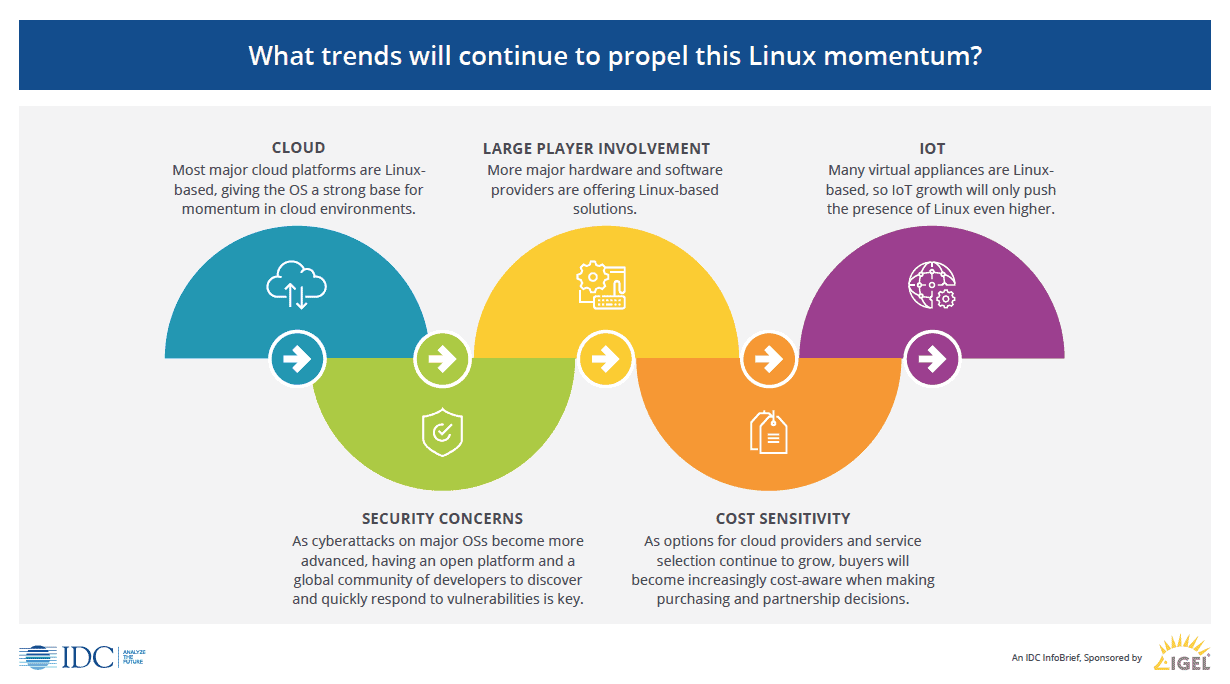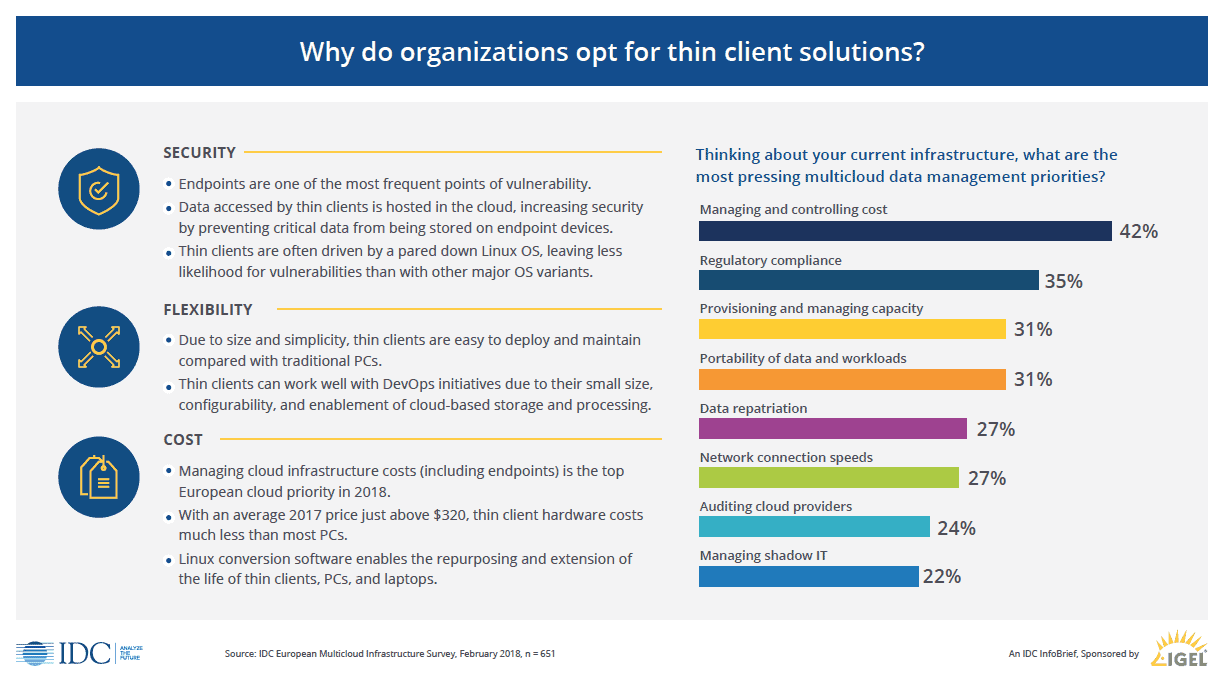IGEL Blog

Key Trends behind Linux’s Momentum for EUC
Linux is fast becoming the OS of choice for the end user computing (EUC) environment. While Windows market share has remained flat, Linux-based endpoint devices are capturing more market share as organizations respond to Linux’ superior customization, security and performance benefits. Notably, Linux-OS powered endpoints are experiencing significant market growth, providing organizations with EUC solutions that support their need to execute on digital transformation with affordable devices that enhance user productivity.
The numbers tell the story: according to a new IDC InfoBrief on the global endpoint market, Linux is the only endpoint operating system (OS) growing at a global level. While Windows market share remains flat, at 39% in 2015 and 2017, Linux has grown from 30% in 2015 to 35% in 2017, worldwide. And the trend is accelerating.
The Market Landscape Fueling Future Linux Growth
IGEL is solidly behind Linux as the preferred OS to deliver EUC at the level of efficiency, security and agility organizations need as they navigate through the challenges of digital transformation. IGEL’s Linux-OS endpoint solutions are proof that organizations can succeed with virtualization by repurposing legacy equipment, centralizing endpoint security and optimization and customizing user profiles so workers get the applications they need to be productive, regardless of device.
IDC identifies five key trends that will fuel Linux momentum:
Cloud. Most major cloud platforms, including Amazon, are Linux based, providing a strong foundation for future growth as spending on cloud infrastructure continues upward. IDC estimates 60% of infrastructure spending will be public or private cloud by 2022, compared to 46% in 2017.
Another driver is the growth of cloud-based delivery of desktop services. It’s been reported that the Desktop-as-a-Service (DaaS) market is expected to grow by 23%, to reach spend of as much as $48.6 billion per year. That presents a large market footprint opportunity for the extension of Linux onto the desktop.
Large Player Involvement. Linux adoption will also rise as major providers like Microsoft increase Linux offerings. Microsoft now has a Linux open source platform, and as IDC notes, this encourages enterprises to become more comfortable with deploying Linux-based solutions. Also, Intel has launched its Clear Linux Project to support cloud and IoT use cases and features a Linux OS designed for use with Intel processors.
IoT. Many virtual appliances are Linux-based, and the proliferation of IoT devices will contribute to further Linux growth. Gartner claims that there were 8.4 billion connected things in 2017 with expectations to rise to 20.4 billion in 2020. Linux adoption will increase as new technologies come on board to simplify management and enhance its features for IoT devices.
Security Concerns. IDC researchers found that improving security remains the top priority (40%) of organizations. Of critical concern is endpoint vulnerability. IGEL answers these concerns with its Linux-OS driven endpoint solutions that offer a number of security benefits superior to other OS choices. Linux is virtually impossible to manipulate and very resistant to viruses and other malware, making it much more secure than Windows. The IGEL OS is a read-only file system, with many embedded security technologies reducing the attack surface for malicious hackers and providing an out-of-the-box integration to many leading technologies. For example, IGEL’s OS works seamlessly with two-factor authentication solution Imprivata used in many hospitals around the world.
Linux also provides the advantages of customization and open source community. As IDC notes, it can be customized to provide direct updates and patches extensively tested for stability by qualified endpoint developers, further ensuring up-to-date performance optimization and security. As an open source platform, Linux fosters innovation from developers around the globe, offering the best in secure, stable software, supported without the risk of end-of-service issues.
Cost Sensitivity. Linux-OS powered endpoint solutions address the global sensitivity to reducing CAPEX. IGEL’s endpoint conversion software, for example, helps organizations extend the life of legacy hardware investments by converting x86-based devices into Linux endpoints.
IDC cautioned, “As options for cloud providers and service selection continue to grow, buyers will become increasingly cost aware when making purchasing and partnership decisions.” That sends a clear message: Linux solutions that are economical, support virtualization and agile enough to embrace new innovation will survive in this hyper-competitive market.
All Trends Lead to Linux
Secure, customizable, endpoint solutions that feature a Linux-based OS offer organizations a means of controlling spend amid proliferating devices and increasing pressure to move more workloads to the cloud. Linux at the endpoint is on the move and data shows this is one trend that won’t be slowing anytime soon.
View the IDC report: Linux and the Endpoint security and optimization Market.


